Spider-Man Remastered Tested: How Does it Run on Your GPU?
With the right settings, you can get smooth play on most graphics cards.
Spider-Man Remastered brings the beloved webslinger to PC, where we'd say he belongs. With higher quality rendering and improved lighting effects, the remastered version ups the image fidelity ante. But what sort of hardware will you need to get a good experience from the game? We've tested a collection of the best graphics cards from AMD and Nvidia, ranging from budget options up to the fastest GPUs available. We've also run through all the settings to find out which ones affect performance and graphics quality the most.
Spider-Man Remastered System Requirements
Let's start with the official PC hardware recommendations from Sony. The company provides five potential configurations, spanning the gamut from 720p at minimum settings for weaker PCs and topping out at 4K and maxed out settings, including ray tracing, for those packing some serious hardware.
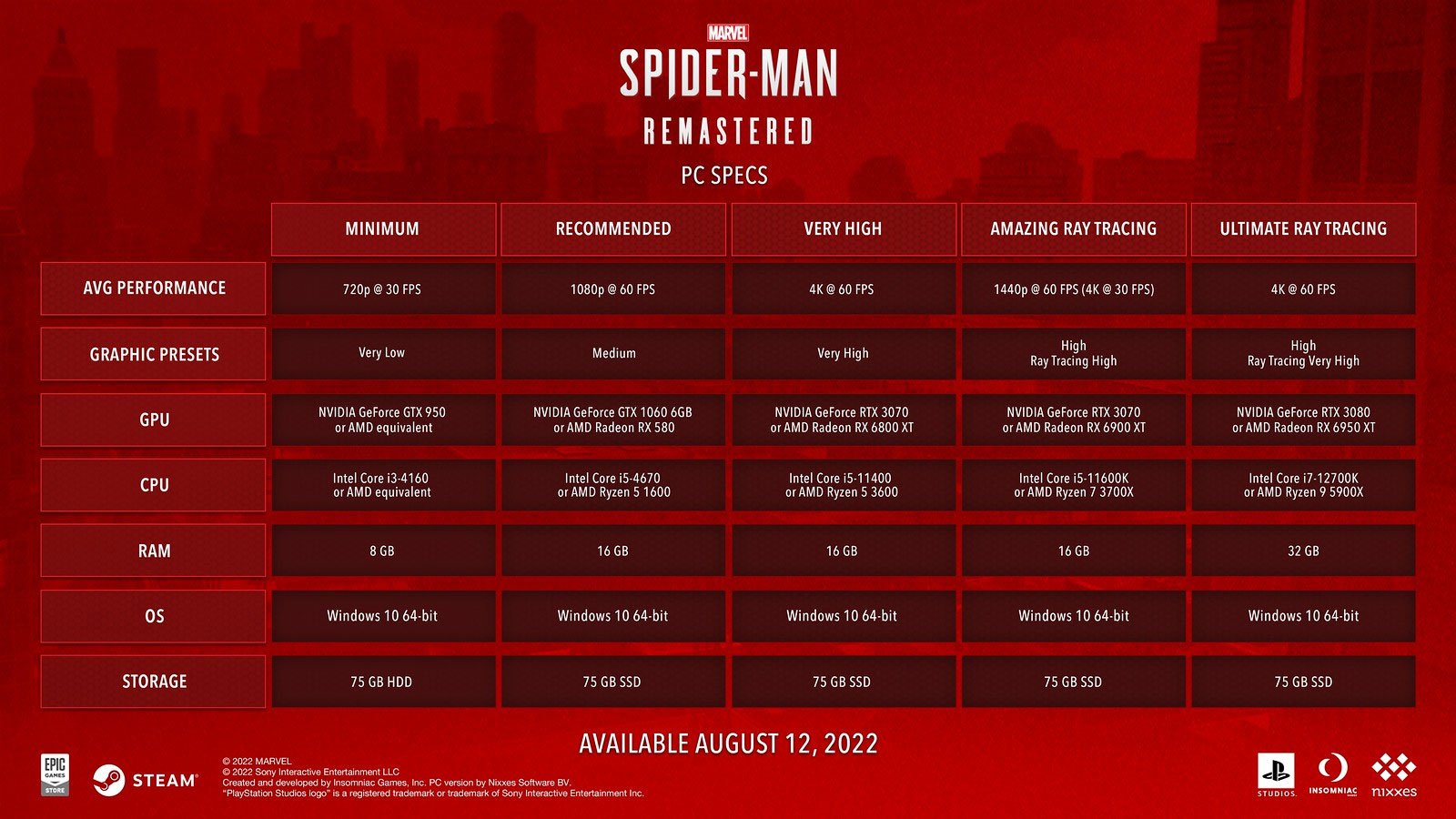
The minimum spec should be in reach of just about anybody. All you need is a GeForce GTX 950 "or AMD equivalent" for 720p at 30 fps. The CPU requirements are also easy enough, with a Core i3-4160 or better. Just about any dedicated graphics card made in the past eight years should suffice, so long as it's an Nvidia GTX (not GT) or AMD RX model. There's no mention of integrated graphics, but we'll see about testing that soon enough.
The recommended specs aren't too bad either, suggesting a GTX 1060 6GB or RX 580, with a 4-core CPU should get the job done and provide 1080p at 60 fps with medium settings. Here Sony actually specifies AMD hardware, though as is often the case it points toward more recent releases. Do you really need a Haswell-era or better Intel CPU? Probably not, at least not for 30 fps, though I didn't try testing on anything other than my top-tier Intel Core i9-12900K.
For the very high preset, running at 4K and 60 fps, there's a big jump in recommended GPU hardware. The RTX 3070 and RX 6800 XT are very much high-end GPUs. Dropping down to 1440p but enabling some ray tracing effects bumps the AMD GPU another level to the RX 6900 XT, and finally for the ultimate ray tracing experience, Sony recommends an RTX 3080 or RX 6950 XT — and 32GB of system memory with one of the fastest CPUs available.
In general, Sony recommends more potent AMD GPUs for the top three settings. The RX 6800 XT normally competes favorably against the RTX 3080, while the RTX 3070 is more of a match for the RX 6700 XT. However, Spider-Man seems to be an Nvidia promoted game, or at least it includes DLSS support alongside FSR 2.0, which may account for presumably better Nvidia performance.
Spider-Man Remastered Settings Analysis
Let's run through the settings on an AMD and Nvidia GPU next, to see which options affect performance and image quality the most. We've tested at 1080p and maxed out settings, except we didn't enable ray-traced reflections and we turned off chromatic aberration because it blurs the outside areas of the screen (and looks like crap, IMO). Then we'll go through each setting and drop it to the minimum value, and enable ray tracing and chromatic aberration on those two settings. We've also tested the five presets: very high, high, medium, low, and very low.

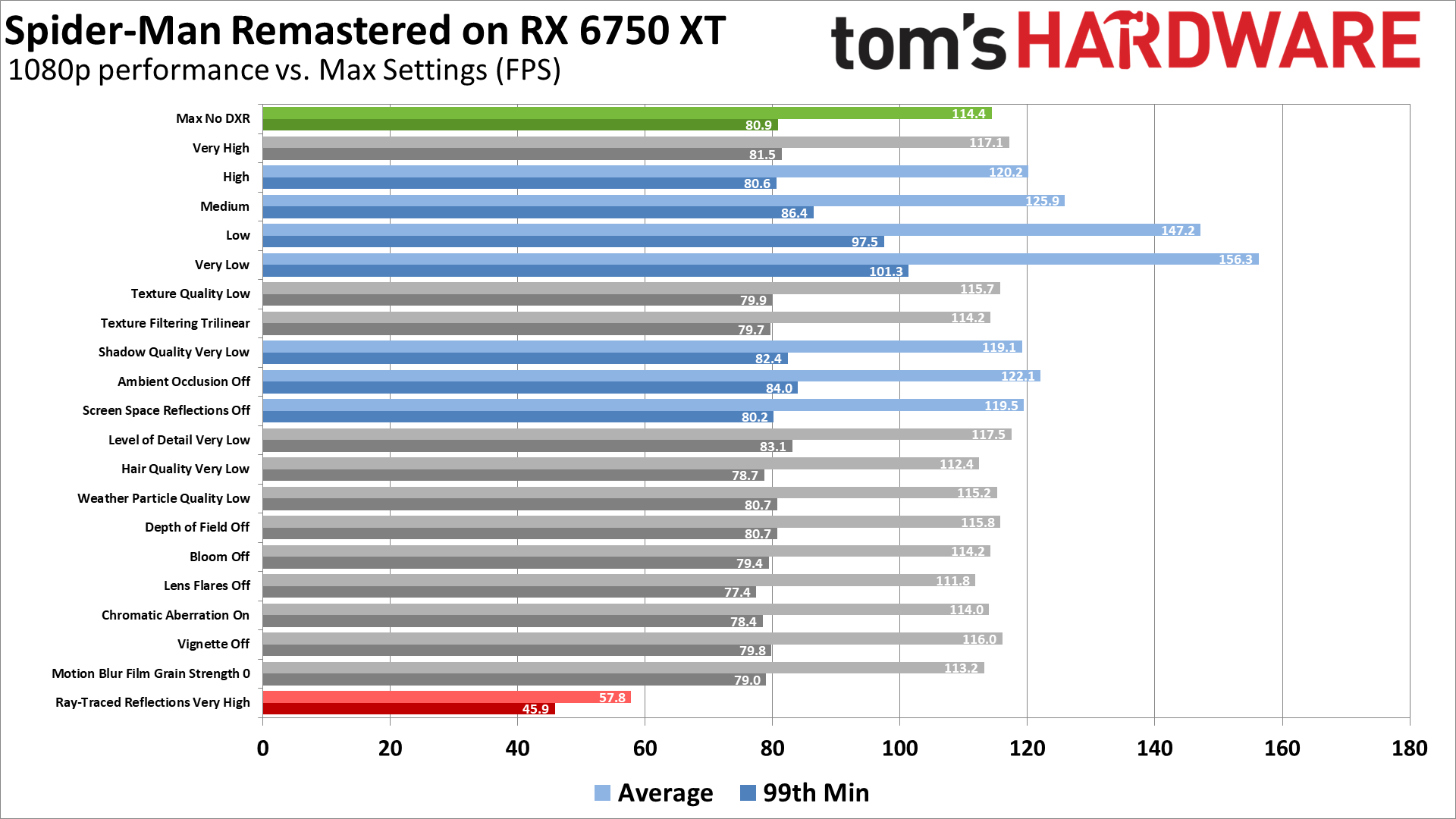




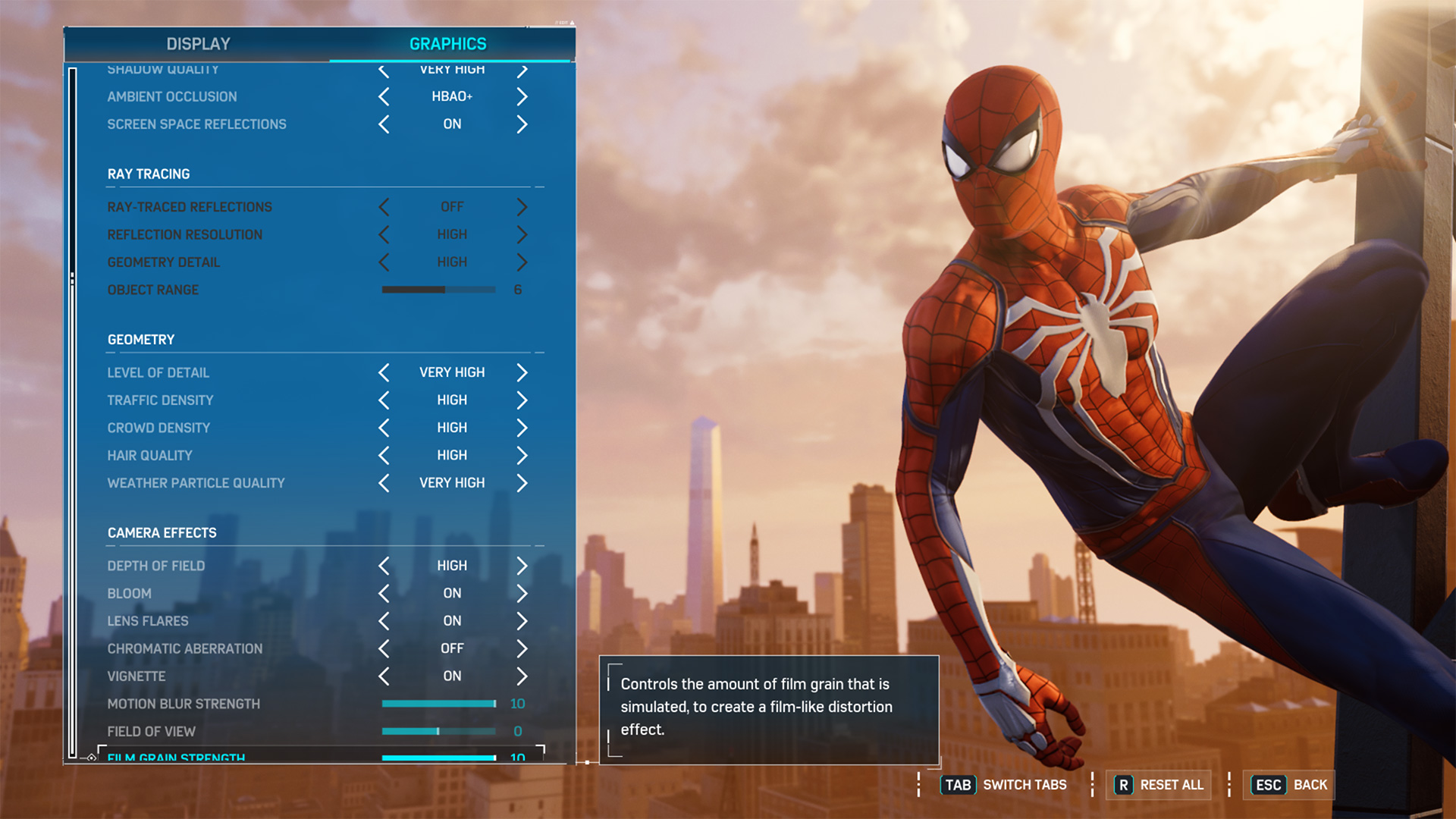
Right off the bat... or spider?... it's pretty clear that the Nvidia GPU performance is punching well above its normal weight class. The RTX 3070 manages 148 fps at 1080p with maxed out settings and appears to be hitting some CPU limits, where the RX 6750 XT — a GPU that normally slightly outperforms the RTX 3070 according to our GPU benchmarks hierarchy — lands at just 114 fps.
Part of that could be drivers, as we tested with Nvidia's Game Ready 516.94 drivers that just came out for this game launch. AMD has not yet released Spider-Man Game Ready drivers, so we tested with the most recent 22.7.1 version. Still, we don't expect drivers alone to make up the 23% deficit. [Update: We've retested the RX 6950 XT, RX 6750 XT, and RX 6600 using newer 22.8.2 drivers, which include Game Ready updates for Spider-Man Remastered. We did not rerun all the settings tests due to time constraints.]
We mentioned that CPU bottlenecks might be limiting performance. The various presets show why. Going from maxed out settings to minimum (Very Low) settings improved performance on the RX 6750 XT by 36%, but on the RTX 3070 it only improved performance by 16%. We also couldn't do better than about 160 fps (give or take) at 1080p medium, even with the fastest graphics cards available.
Looking at the individual settings, on Nvidia the only option that makes more than a 3% difference in performance is ray tracing, where the maxed out Ray-Traced Reflections dropped performance by 54%. Otherwise, everything else is margin of error — there's no built-in benchmark, so we manually recorded frametimes while webslinging around the city. Dropping Texture Quality, Texture Filtering, and Ambient Occlusion to their minimum values boosted framerates a couple of percent, but that's about it.
On the AMD side of things, Shadow Quality, Ambient Occlusion, and Screen Space Reflections all had a slightly larger impact on performance. Conversely, ray tracing 'only' dropped performance by 49.5%. Considering AMD normally has inferior ray tracing hardware, that's a bit unusual.
Speaking of ray tracing, Sony released an updated version of Spider-Man Remastered as we wrapped up testing. It changed the settings menu a bit, providing slightly more options for refining the ray tracing settings. Where before there was a single "Ray-Traced Reflections" option that could be set to medium, high, or very high, now there are three settings: Reflection Resolution, Geometry Detail, and Object Range (along with a toggle for Ray-Traced Reflections). Sony says maxing out the object range now represents a slightly more demanding workload than the previous Very High setting for ray-traced reflections. However, in practice it seems there's a negligible difference in performance (less than one percent).






Given the lack of impact from most of the settings, we'll confine our image quality comparisons to the presets. We have maxed out settings, including ray tracing, plus the five presets in the above gallery.
While screen space reflections are available, these "fake reflections" clearly aren't accurate, as you can see by comparing the windows in the first and second images. SSR might be superficially convincing if all you're looking for is the hint of reflections, but the trees end up filling the windows on the right side of the screenshot, where DXR correctly shows the reflected "Re-elect Osborn" banner. It's a small but noticeable thing, even if losing half your framerate is painful.
The key difference between the Very High and High presets is in the shadows, or more correctly the ambient occlusion. HBAO+ (Horizon Based Ambient Occlusion Plus) is used for the Very High preset, while SSAO (Screen Space Ambient Occlusion) is used on the other presets (except Very Low where AO is off). SSAO puts shadows underneath the vehicles and Spider-Man, even when they're not in direct lighting and wouldn't really cast a shadow. Ray-traced lighting would do a better job, but that would of course further reduce the frame rates for relatively minor gains in shadow quality.
The High, Medium, and even Low presets generally look very similar. Low takes a hit in texture quality that's visible, but that's the only major change. Very Low meanwhile disables SSAO as well, which actually makes it look a bit closer to the Very High preset in some areas, though it's clearly worse in other aspects.
Get Tom's Hardware's best news and in-depth reviews, straight to your inbox.




The good news is that most graphics cards should be able to handle the Very High preset at 1080p, based on our testing. The only setting we strongly recommend against using is Chromatic Aberration, and we'd keep Texture Quality as high as your VRAM allows — and 6GB is enough for the Very High setting.
If you view the full-size images in the above gallery, you can see the blurriness that both of those cause. The same goes for Texture Filtering, where you'll want at least some level of anisotropic filtering (4x should be good) to avoid some blurring of textures that are viewed at an oblique angle.

Spider-Man Remastered Standard Performance
Let's move on to the benchmarks. We've selected eight GPUs, four each for AMD and Nvidia. We chose budget, midrange, high-end, and extreme GPUs from both sides, with relatively similar retail pricing (except for the extreme options, where the RTX 3090 Ti still costs quite a bit more). We tested at 1080p medium, and then 1080p, 1440p, and 4K with maxed out settings — which basically look the same as the Very High preset, but we bumped up to 16x anisotropic filtering, very high shadow quality, and very high level of detail.
We've also added the AMD results using newer 22.8.2 drivers, which improved performance anywhere from 2% to 10%, depending on your GPU and settings. Except, there are a few cases where the newer drivers didn't seem to help (e.g. the RX 6600 at 1440p and 4K).

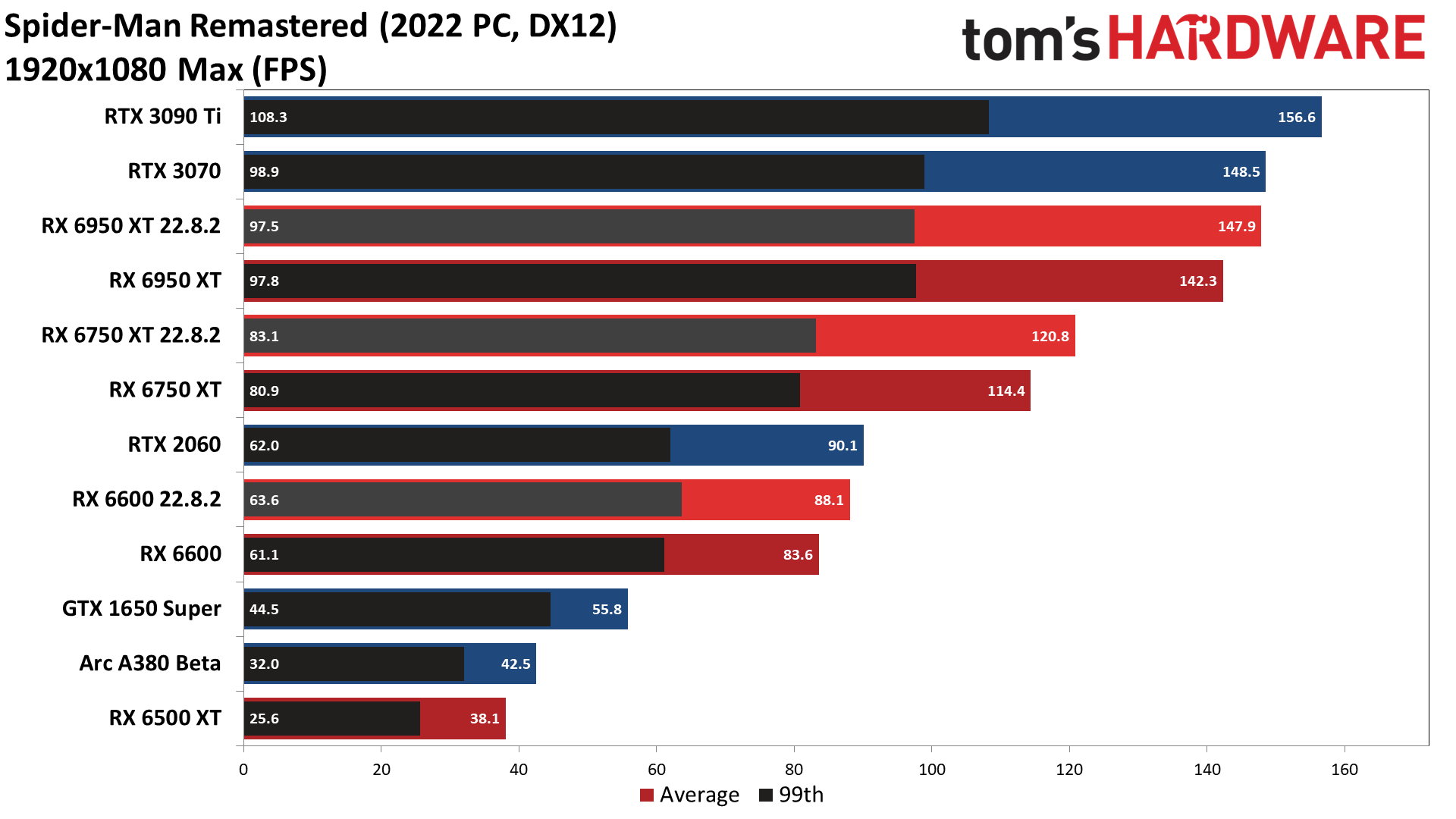


Starting with 1080p medium, the top three GPUs are basically tied, with CPU bottlenecks likely being the culprit. That's not too surprising, though the fact that the RTX 3070 comes out just ahead of the RX 6950 XT does raise an eyebrow. As stated earlier, Spider-Man Remastered appears to be an Nvidia promotional game, and certainly that shows here.
The RTX 3070 easily outpaces the normally similar performing RX 6750 XT, with a 20% lead. It's basically the reverse of what we've seen in Assassin's Creed Valhalla (an AMD promoted game where AMD GPUs trounce their Nvidia counterparts). The RTX 2060 meanwhile just edges past the RX 6600, and both are available for around $250 these days — which is sort of funny, since the RTX 2060 is faster than the RTX 3050 that still sells for over $300. Finally, the GTX 1650 Super also easily beats the RX 6500 XT, by 43% where normally they're pretty evenly matched.
Things don't change much at 1080p and maxed out settings, except the GTX 1650 Super now falls below 60 fps. The RTX 3090 Ti still runs into CPU limitations, and the RTX 3070 is now 23% faster than the RX 6750 XT. Also note that the RX 6600 is usually about 20% faster than the RTX 2060, but here the RTX 2060 is 2% faster (with the new drivers closing the gap by about 5%).
At 1440p, the RX 6950 XT is finally able to leverage its additional memory bandwidth and passes the RTX 3070, and the RTX 3090 Ti starts to pull away — it's still CPU limited, though, as it only dropped 3 fps compared to 1080p. The RX 6600 is also able to pull just ahead of the RTX 2060, but the RX 6500 XT that was already struggling at 1080p and falls well below 30 fps, so we dropped it from the charts (18 fps was what we measured, which was basically unplayable).
Finally, at 4K and maximum quality without ray tracing, things start to look more like what we'd normally expect to see. The RTX 3090 Ti still holds a large lead of 20% over the RX 6950 XT, which is more than what we see in our overall GPU benchmarks score, but the 3090 Ti is anywhere from 10% slower to 30% faster across our full suite of games. Spider-Man Remastered lands at the higher end of that range, but it's not a complete outlier at 4K. RX 6600 also leads the RTX 2060, and the RX 6750 XT with updated drivers takes a negligible 1% lead over the RTX 3070.
Spider-Man Remastered Integrated Graphics and 2GB GPUs



We did mention attempting to run Spider-Man Remastered on integrated graphics as well. Above, you can see what it looked like with Intel Iris Xe (Core i7-1165G7) at 720p and Very Low settings, compared to the same settings on a GTX 1050. Performance was only around 6 fps, basically a slideshow, and upscaling didn't help matters.
Color me shocked — shocked, I say! Intel, the maker of the world's most popular graphics solutions, has driver issues yet again? I suppose it's got bigger fish to fry, like making its Arc A380 work properly. Except, this isn't a DirectX 11 game.
We did actually track down the root problem, which appears to be turning Ambient Occlusion to "Off" or using HBAO+. Using SSAO fixes the rendering, though the game remains unplayable — and it's also unplayable on an Arc A380 using the July 29 drivers, where it averaged just 15.5 fps at 1280x720 with Very Low settings (but with SSAO enabled). It also averaged 14.2 fps at 1080p with those same settings, so something appears to be limiting performance besides GPU compute and bandwidth.
Intel did provide us with access to updated drivers after our initial article went live, which specifically address the poor performance in Spider-Man Remastered. You can see how much those help, which is hopefully something we'll see less of as the drivers mature. The drivers had a "bug" according to Intel, on that happened to cut performance by 75% or so. Too bad it wasn't a radioactive bug that gave the A380 super powers...
In comparison, Spider-Man Remastered did run just fine on a GTX 1050, a card with only 2GB VRAM. It didn't break 60 fps, but it was very much playable at 720p and mostly playable at 1080p — though performance dropped to just 31 fps at 1080p medium, with 1% lows of 21 fps. An AMD RX 550 4GB, which provides similar performance to AMD Vega 8 integrated solutions, also did okay at 720p with minimum settings but dropped to 25 fps at 1080p.
What about something even older, that's not on the approved list of GPUs? I tried a GTX 650 Ti Boost (2GB), using Nvidia's 473.81 drivers — the latest available for Windows 10/11 64-bit. Performance was marginal at 720p Very Low, around 24 fps, but there were also rendering errors. It wasn't as bad as on Intel's integrated graphics, but it wasn't great, as you can see in the above video. Hmm.
To be fair, Spider-Man Remastered gives a driver warning for the GTX 650 Ti Boost, and that's a pretty old card — it came out in early 2013. It's also a relatively slow GPU by today's standards, with 768 CUDA cores providing a mere 1.5 TFLOPS of FP32 compute performance. What about something a bit newer and faster, like a GTX 780? I tried that as well. It ran much better, at 63 fps with 720p and Very Low settings... but it still had some rendering errors. So, you'll probably want to stick with the recommended GTX 900-series or newer (or the Maxwell-based GTX 750 or 750 Ti).
Note that Spider-Man appears to want a frame rate of at least 20–24 fps. If your PC falls below that mark, the game starts to slow down. The occasional dip below that range might still be tolerable, but anything averaging 20 fps feels very sluggish compared to how the game normally runs.

Spider-Man Remastered Ray Tracing Performance




Next up are the ray tracing charts, which means the GTX 1650 Super falls by the wayside. Not that the budget RX 6500 XT does much better, as even with "medium" ray-traced reflections enabled it only averages 20 fps. The RTX 3090 Ti and RTX 3070 still end up basically tied at 1080p medium with DXR, while the RX 6950 XT and RX 6750 XT are about 15% slower and also land close together. Nvidia's RTX 2060, meanwhile, leads the RX 6600 by a whopping 36% — which actually isn't too far out of the norm for complex ray tracing games.
AMD's updated drivers don't seem to help performance with DXR enabled, but part of that is likely due to Sony / Insomniac changing the ray tracing settings. Before, there was a single option for Ray-Traced Reflections, but that's now been replaced with three settings. It's not exactly clear what new settings correspond to the old "Medium" and "Ultra" settings for RTR, and likely the options we used (High/High/5 and Very High/Very High/10) aren't the same as the previous settings.
Bumping up to maxed-out settings, the RX 5600 XT gets dropped like a bad habit, and the RTX 3090 Ti's lead over the RX 6950 XT grows to 24%. RTX 3070 falls a bit behind the 6950, but it's also 21% faster than the 6750 XT. And for budget ray tracing, the RTX 2060 comes out 53% ahead of the RX 6600.
1440p and maxed-out settings with ray tracing remains nearly playable on the five GPUs in our chart, though the RTX 2060 is certainly borderline — DLSS or FSR2 would help, which we'll get to in a moment. The 6950 XT and 3090 Ti meanwhile still average over 60 fps.
Finally, at 4K with the dial cranked to 11, even the RTX 3090 Ti falls below 60 fps. The RX 6950 XT meanwhile manages 40 fps, which is playable but not as smooth as we'd like. The RTX 3070 and RX 6750 XT drop below 30 fps as well, which was expected given what we saw at 1440p. Let's see what FSR 2.0 and DLSS can do for performance.
Spider-Man Remastered Upscaling Performance
Depending on your GPU, Spider-Man Remastered has three different upscaling algorithms available: Nvidia DLSS, AMD FSR 2.0, and IGTI — Insomnia Games Temporal Injection. We only tested upscaling on the RTX 3070 and RX 6750 XT, just to keep our sanity as we've already run the test sequence several hundred times. (pray for me!)




As noted already, CPU limits are still in effect at 1080p medium with DXR (DirectX Raytracing). The RTX 3070 gets 116–119 fps, with or without upscaling. The RX 6750 meanwhile gets 98–99 fps at native and with IGTI, while FSR 2.0 gives it a small bump to 102 fps. The CPU bottlenecks start to go away at 1080p with maxed-out settings, however.
The RTX 3070 gets 72 fps while running at native resolution. With the three different upscaling options, all using the "Quality" mode, performance improves to 92–94 fps. IGTI delivers slightly higher performance for Nvidia (32% higher than native), while DLSS and FSR 2.0 both improved performance by 29%. For AMD, ITGI provides the same performance benefit as FSR 2.0, a 25% improvement over native.
As the resolution increases, the benefits of upscaling also become greater. At 1440p, DLSS gives the RTX 3070 a 24% boost (slightly less than at 1080p, probably margin of error), FSR 2.0 improves performance by 30%, and IGTI provides a 46% increase in fps. The RX 6750 XT meanwhile gets 40% more performance from FSR 2.0 and 43% from IGTO.
Finally, 4K upscaling allows both GPUs to go from unplayable framerates to more than 30 fps — not perfectly smooth, but certainly adequate. The RTX 3070 gets a 46% boost from FSR 2.0 this time, 52% from DLSS, and a massive 83% improvement from IGTI. Of course, as we'll see in a moment, IGTI undoubtedly provides the worst quality of scaling out of the three. The RX 6750 XT on the other hand sees a 69% increase from FSR 2.0 and 75% from IGTI.
We've focused on upscaling with DXR enabled, but you can also use it with standard rendering. CPU limits naturally become an issue on faster GPUs, however. The RTX 3070 for example only improved by 5% at 1080p without DXR, but it was 30% faster at 1440p and 45% faster at 4K (using DLSS Quality mode). The RX 6750 XT by contrast wasn't hitting CPU limits as hard, so it improved by 17% at 1080p medium, 22% at 1080p max, 26% at 1440p, and 40% at 4K.
The great thing about FSR 2.0 is that it will work with pretty much any GPU, though the gains might not be as great. We also only did detailed performance testing with Quality upscaling modes. We wouldn't recommend using the Performance mode at 1080p, but you can certainly get away with it at 4K.
Spider-Man Remastered: Upscaling Algorithm Image Fidelity


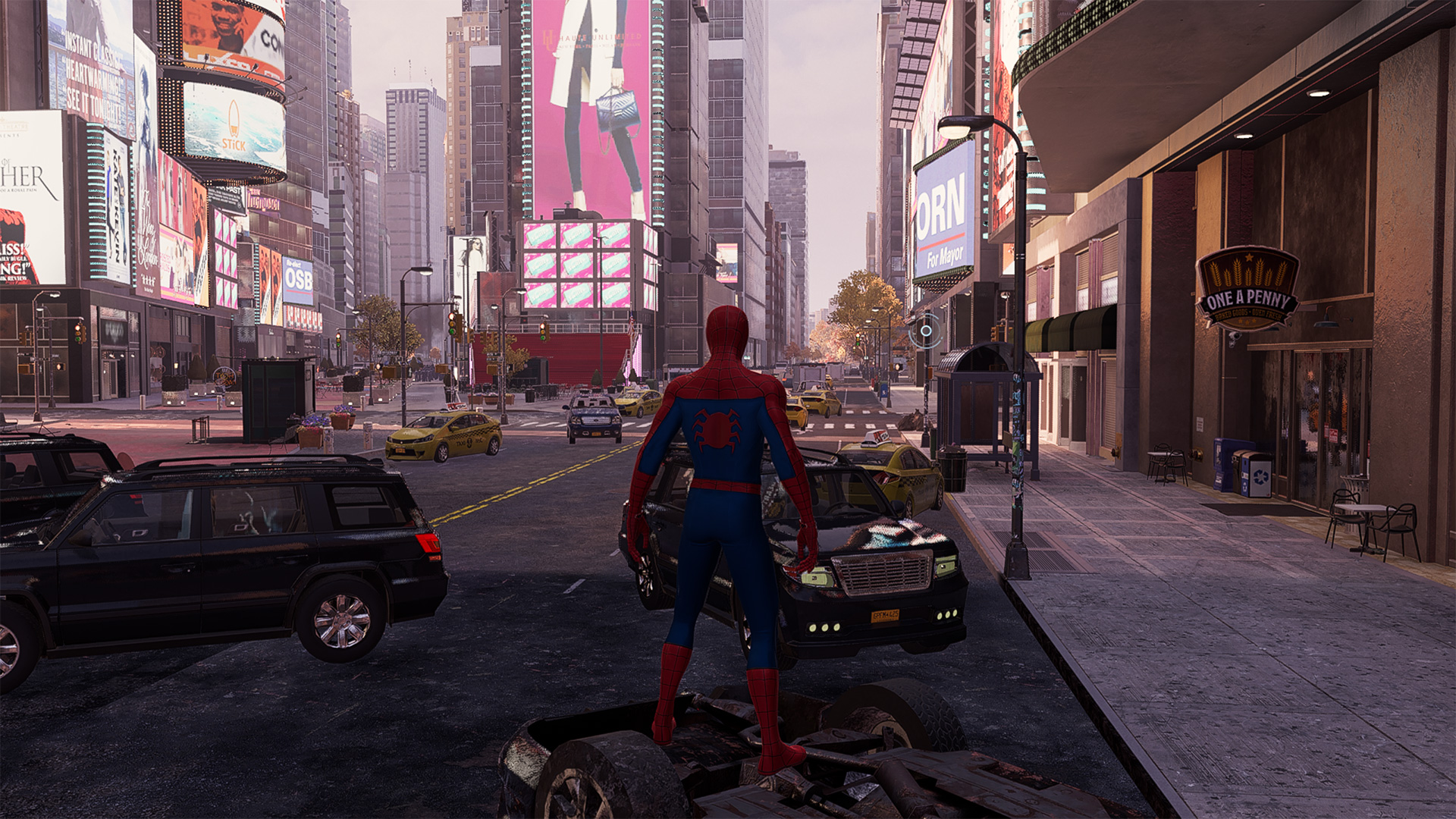


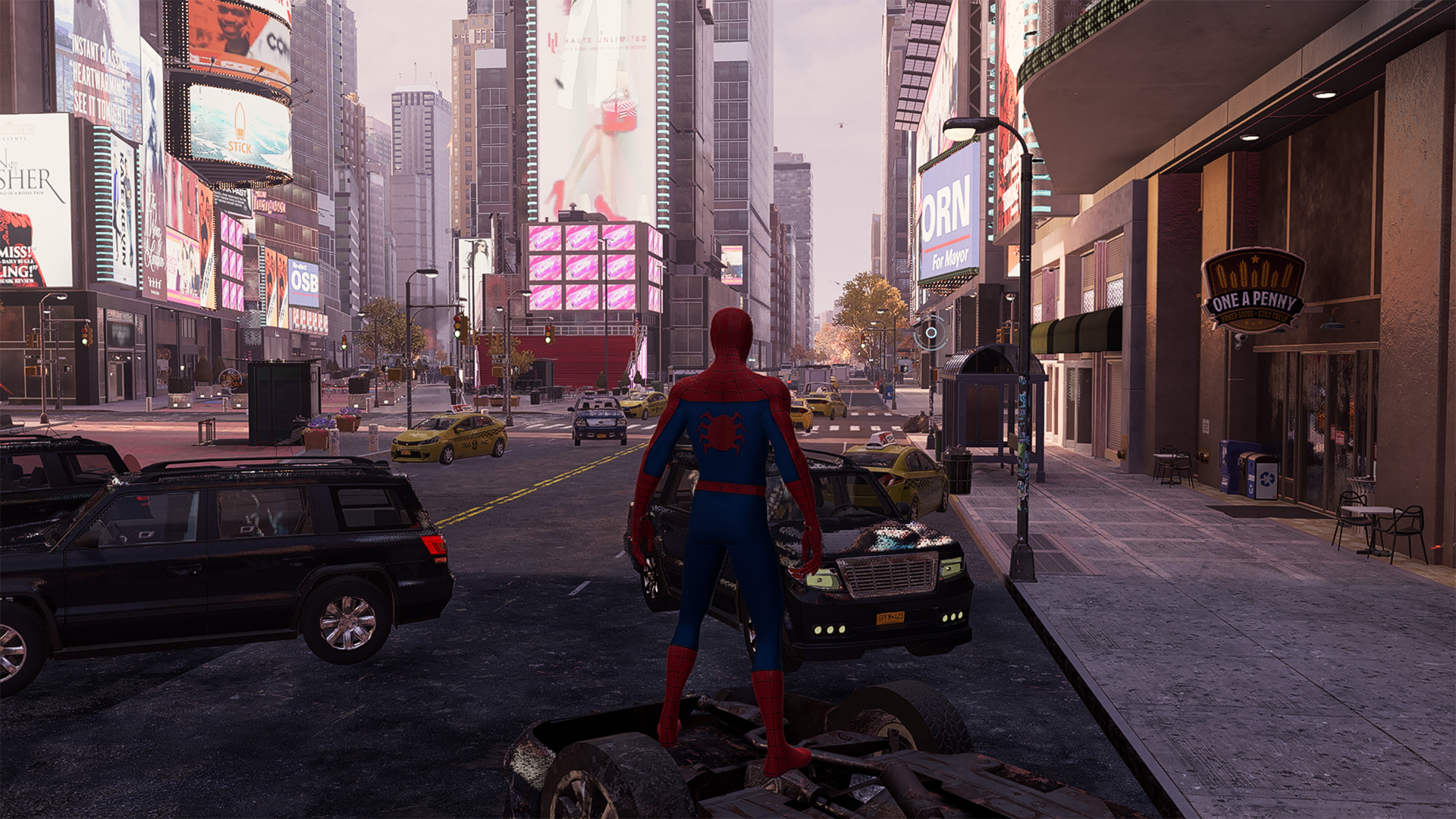

Upscaling performance isn't the only factor to consider, as a poor quality upscaler might make any fps gains meaningless. Above — and again, you'll want to view the original images — you can see the native mode compared to the Quality and Performance modes for the three upscaling algorithms.
In general, with Quality mode upscaling, we found DLSS and FSR 2.0 looked pretty comparable, with DLSS taking the overall image fidelity crown. The grill on the car right in front of Spider-Man, as well as the lines on the buildings, both look better with DLSS enabled in our view. FSR 2.0 is close, but IGTI looks far worse.
Turning to the Performance modes, DLSS and FSR 2.0 still look okay, though some things like the reflection on the hood of the car definitely look worse than at native. The lines on the buildings still "pop" a lot more, though whether that's actually correct or not is debatable. IGTI meanwhile looks very blurry, and it's something we'd only recommend using if you have a very slow or old GPU.

One thing to mention is that, while you can't see it as much in the still screenshots, there's some occasional temporal distortion with the upscaling solutions enabled. Look at this one, paying attention to Spider-Man's arms. This is with FSR 2.0 Performance mode, and it looked really bad until we exited and restarted.
It sounds as though Sony is still working to improve the upscaling results, however, so you might not see these problems if you're playing days after launch. It's also a reminder that upscaling solutions aren't simple plug-and-play algorithms. You need to provide the right data, in the best format. Otherwise, it's garbage in, garbage out.

Spider-Man Remastered: Closing Thoughts
Some may feel otherwise, but the addition of keyboard and mouse support in Spider-Man Remastered's PC port is great. Swinging around the city, I at least wouldn't know from the feel of things that this is a console port. It's too bad it took Sony four years to get around to making this happen, but this is undoubtedly the definitive edition, particularly if you have a potent PC and can run it with all the bells and whistles enabled. Hopefully, Sony will bring the Miles Morales sequel to PC sooner rather than later.
Make no mistake, the ray-traced reflections are very demanding of your GPU, but they do look better. You can definitely play without them, and you might not notice they're missing. But there are plenty of times where the screen space reflections just look wrong once you've played with RT enabled.
Overall, however, even with maxed-out settings, Spider-Man Remastered runs quite well. The RTX 2060 for example is eminently playable at 1080p, particularly with DLSS or FSR 2.0 enabled. AMD RX 6000-series owners can also handle 1080p on cards as low as the RX 6600, once you turn on FSR 2.0, though RX 6500 XT or RX 6400 owners will probably want to play without ray tracing enabled. Turn off ray tracing and run at medium settings and just about any dedicated graphics card should easily break 30 fps, and often 60 fps.
It's also exciting to see a new major game launching with both DLSS and FSR 2.0 support out of the box. Nvidia has sent out some PR blasts talking about the DLSS support, which in the past has usually meant a game wouldn't get FSR support until later, if ever. That means anyone and everyone that plays Spider-Man Remastered will have a good upscaling option available. We'd still use DLSS if you have an RTX card, but at least AMD users and Nvidia GTX owners won't get left out in the cold.
Spider-Man Remastered launches on August 12, 2022, on both Steam and the Epic Games Store. Sony provided us with a pre-release copy for purposes of this technical overview.

Jarred Walton is a senior editor at Tom's Hardware focusing on everything GPU. He has been working as a tech journalist since 2004, writing for AnandTech, Maximum PC, and PC Gamer. From the first S3 Virge '3D decelerators' to today's GPUs, Jarred keeps up with all the latest graphics trends and is the one to ask about game performance.
-
TechyInAZ This port looks amazing, and I'm very glad Sony decided to pour time and effort into making this a good port -- as if it was made intentionally for PC, instead of just porting it just for the sake of it.Reply
My RTX 2060 Super is gonna cry though. I game at 3440x1440 on what many people argue is a 1080P card. But my intentions are to run high settings, with the lowest RT reflection settings enabled. I hope I can get above 60FPS at the very least with DLSS in performance mode.
I'm glad the game is finally here. I've heard nothing but good reviews about it, and i've been dying to try it out. Lets hope Sony's next PC port -- this time for Uncharted, will be just as good. -
Makaveli I'm going to be getting this on friday and will be running it at 3440x1440 on a 6800XT so I think I should be able to play with very high settings I will just have to see how much of a hit tracing will be. Don't really plan to use any upscaling.Reply -
JarredWaltonGPU Reply
The 6800 XT won't be that much slower than the RX 6950 XT, and 3440x1440 is less demanding than 4K. You're probably looking at around 60-70 fps without ray tracing, maybe 55-60 fps with "medium" RT reflections.Makaveli said:I'm going to be getting this on friday and will be running it at 3440x1440 on a 6800XT so I think I should be able to play with very high settings I will just have to see how much of a hit tracing will be. Don't really plan to use any upscaling. -
Makaveli ReplyJarredWaltonGPU said:The 6800 XT won't be that much slower than the RX 6950 XT, and 3440x1440 is less demanding than 4K. You're probably looking at around 60-70 fps without ray tracing, maybe 55-60 fps with "medium" RT reflections.
That's what I want to hear! -
cknobman Hate "sponsored" titles, code for Nvidia paid to have AMD GPU performance limited.Reply
Hard pass. -
salgado18 Very indepth, like it very much. Just wish you could take the time to update the article with lesser GPUs, including integrated. Sure, the Intel one does 6 fps, but that's not surprising, is it? What about the 5700G, or the very successful 3400G? And VRAM, how much is too little? Can I game with less than 4GB?Reply -
JarredWaltonGPU Reply
Yeah, the difficulty is that every GPU tested adds time to the task, anywhere from about 15 minutes to 45 minutes depending on how many different settings and resolutions I test. And testing on more than one system is a pain because I have to copy (or redownload) the game to each system. I'll do a quick test of the GTX 1050, which is one of the few 2GB cards I have that's worth considering. Anyone have another pressing GPU question, LMK and I can see about running a few tests. I'll post results here...salgado18 said:Very indepth, like it very much. Just wish you could take the time to update the article with lesser GPUs, including integrated. Sure, the Intel one does 6 fps, but that's not surprising, is it? What about the 5700G, or the very successful 3400G? And VRAM, how much is too little? Can I game with less than 4GB?
GTX 1050 results (all at native, no upscaling):
1280x720 Very Low: avg: 52.5 fps, 1% low: 34.8 fps
1920x1080 Very Low: avg: 36.3 fps, 1% low: 26.9 fps
1920x1080 Medium: avg: 31.5 fps, 1% low: 21.3 fps
So, 720p is definitely playable, 1080p minimum is okay as well. 1080p medium feels sluggish but you could manage it if you really want.
I also tested the Radeon RX 550 4GB. It has more VRAM but a lower power limit, fewer shader cores, and is generally quite slow. It's basically on par with AMD's integrated Vega 8 graphics. Here are the results:
RX 550 4GB results (all at native, no upscaling):
1280x720 Very Low: avg: 38.6 fps, 1% low: 24.6 fps
1920x1080 Very Low: avg: 25.3 fps, 1% low: 17.6 fps
You can see that 720p minimum is still basically playable, but 1080p proves a bit too much. The game engine starts to slow down when it falls below ~20 fps, maybe 24 fps. So for example, my test sequence consists of running through a section of the city in a loop. It takes about a minute and I end up close to where I started, so that I can repeat the test. On the RX 550, I only made it about 90% of the way back to the normal stopping point. -
Player1096769 Reply
Good evening sirJarredWaltonGPU said:Yeah, the difficulty is that every GPU tested adds time to the task, anywhere from about 15 minutes to 45 minutes depending on how many different settings and resolutions I test. And testing on more than one system is a pain because I have to copy (or redownload) the game to each system. I'll do a quick test of the GTX 1050, which is one of the few 2GB cards I have that's worth considering. Anyone have another pressing GPU question, LMK and I can see about running a few tests. I'll post results here...
GTX 1050 results (all at native, no upscaling):
1280x720 Very Low: avg: 52.5 fps, 1% low: 34.8 fps
1920x1080 Very Low: avg: 36.3 fps, 1% low: 26.9 fps
1920x1080 Medium: avg: 31.5 fps, 1% low: 21.3 fps
So, 720p is definitely playable, 1080p minimum is okay as well. 1080p medium feels sluggish but you could manage it if you really want.
I also tested the Radeon RX 550 4GB. It has more VRAM but a lower power limit, fewer shader cores, and is generally quite slow. It's basically on par with AMD's integrated Vega 8 graphics. Here are the results:
RX 550 4GB results (all at native, no upscaling):
1280x720 Very Low: avg: 38.6 fps, 1% low: 24.6 fps
1920x1080 Very Low: avg: 25.3 fps, 1% low: 17.6 fps
You can see that 720p minimum is still basically playable, but 1080p proves a bit too much. The game engine starts to slow down when it falls below ~20 fps, maybe 24 fps. So for example, my test sequence consists of running through a section of the city in a loop. It takes about a minute and I end up close to where I started, so that I can repeat the test. On the RX 550, I only made it about 90% of the way back to the normal stopping point.
Can you please recommend on which setting should I play on my amd ryzen 5 3500U,vega 8 2gb to get around 30-35fps?

